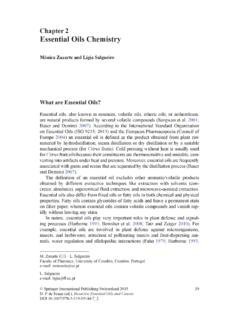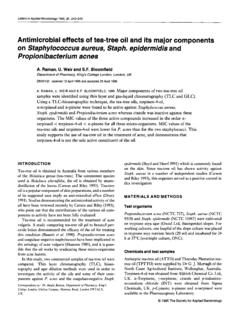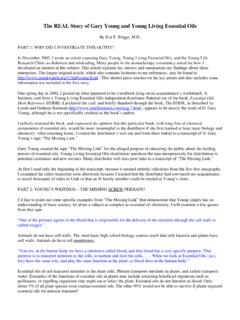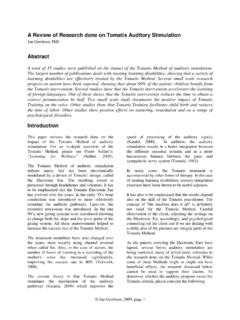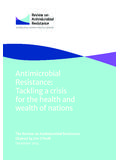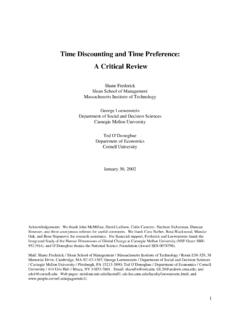Transcription of Review Essential oils: their antibacterial properties …
1 ReviewEssential oils : their antibacterial properties and potentialapplications in foods a reviewSara Burt*Department of Public Health and Food Safety, Faculty of Veterinary Medicine, University of Utrecht, Box 80175,3508 TD Utrecht, The NetherlandsReceived 14 November 2003; accepted 3 March 2004 AbstractIn vitro studies have demonstrated antibacterial activity of Essential oils (EOs) againstListeria monocytogenes,Salmonellatyphimurium,Esch erichia coliO157:H7,Shigella dysenteria,Bacillus cereusandStaphylococcus aureusat levels between 10 Alml 1. Gram-negative organisms are slightly less susceptible than gram-positive bacteria. A number of EOcomponents has been identified as effective antibacterials, carvacrol, thymol, eugenol, perillaldehyde, cinnamaldehyde andcinnamic acid, having minimum inhibitory concentrations (MICs) of 5 Alml 1in vitro.
2 A higher concentration is neededto achieve the same effect in foods. Studies with fresh meat, meat products, fish, milk, dairy products, vegetables, fruit andcooked rice have shown that the concentration needed to achieve a significant antibacterial effect is around 20 Alg 1infoods and about 10 Alml 1in solutions for washing fruit and vegetables. EOs comprise a large number of components andit is likely that their mode of action involves several targets in the bacterial cell. The hydrophobicity of EOs enables them topartition in the lipids of the cell membrane and mitochondria, rendering them permeable and leading to leakage of cell conditions that improve the action of EOs are low pH, low temperature and low oxygen levels. Synergism has beenobserved between carvacrol and its precursorp-cymene and between cinnamaldehyde and eugenol.
3 Synergy between EOcomponents and mild preservation methods has also been observed. Some EO components are legally registered flavourings inthe EU and the USA. Undesirable organoleptic effects can be limited by careful selection of EOs according to the type of Elsevier All rights : Essential oils ; antibacterial ; Preservatives; Food borne pathogens1. IntroductionIn spite of modern improvements in slaughterhygiene and food production techniques, food safetyis an increasingly important public health issue(WHO, 2002a). It has been estimated that as manyas 30% of people in industrialised countries sufferfrom a food borne disease each year and in 2000 atleast two million people died from diarrhoeal diseaseworldwide(WHO, 2002a). There is therefore still aneed for new methods of reducing or eliminating foodborne pathogens, possibly in combination with exist-ing methods (the hurdle principle;Leistner, 1978).
4 Atthe same time, Western society appears to be experi-encing a trend of green consumerism(Tuley deSilva, 1996; Smid and Gorris, 1999), desiring fewersynthetic food additives and products with a smaller0168-1605/$ - see front matterD2004 Elsevier All rights * Tel.: +31-30-2535350; fax: + (S. Burt). Journal of Food Microbiology 94 (2004) 223 253impact on the environment. Furthermore, the WorldHealth Organization has recently called for a world-wide reduction in the consumption of salt in order toreduce the incidence of cardio-vascular disease(WHO, 2002b). If the level of salt in processed foodsis reduced, it is possible that other additives will beneeded to maintain the safety of foods. There istherefore scope for new methods of making food safewhich have a natural or green image. One suchpossibility is the use of Essential oils as oils (EOs) (also called volatile or etherealoils;Guenther, 1948) are aromatic oily liquids ob-tained from plant material (flowers, buds, seeds,leaves, twigs, bark, herbs, wood, fruits and roots).
5 They can be obtained by expression, fermentation,enfleurage or extraction but the method of steamdistillation is most commonly used for commercialproduction of EOs(Van de Braak and Leijten, 1999).The term Essential oil is thought to derive from thename coined in the 16th century by the Swiss reform-er of medicine, Paracelsus von Hohenheim; he namedthe effective component of a drugQuinta essentia(Guenther, 1948). An estimated 3000 EOs are known,of which about 300 are commercially important destined chiefly for the flavours and fragrances market(Van de Braak and Leijten, 1999). It has long beenrecognised that some EOs have antimicrobial proper-ties(Guenther, 1948; Boyle, 1955)and these havebeen reviewed in the past(Shelef, 1983; Nychas,1995)as have the antimicrobial properties of spices(Shelef, 1983)but the relatively recent enhancementof interest in green consumerism has lead to arenewal of scientific interest in these substances(Nychas, 1995; Tuley de Silva, 1996).
6 Besides anti-bacterial properties (Deans and Ritchie, 1987; Carsonet al., 1995a; Mourey and Canillac, 2002), EOs ortheir components have been shown to exhibit antiviral(Bishop, 1995), antimycotic(Azzouz and Bullerman,1982; Akgu l and Kivanc , 1988; Jayashree and Sub-ramanyam, 1999; Mari et al., 2003), antitoxigenic(Akgu l et al., 1991; Ultee and Smid, 2001; Juglal etal., 2002), antiparasitic(Pandey et al., 2000; Pessoa etal., 2002), and insecticidal(Konstantopoulou et al.,1992; Karpouhtsis et al., 1998) properties . Thesecharacteristics are possibly related to the function ofthese compounds in plants(Guenther, 1948; Mah-moud and Croteau, 2002).The purpose of this paper is to provide an overviewof the published data on the antibacterial activity ofthose EOs and their components that could be con-sidered suitable for application in or on foods, and todescribe their possible modes of action.
7 The currentknowledge on potential antagonists and synergists ispresented; legal and safety aspects are discussed andareas for future research are proposed. Although somedata are presented on spoilage flora, this paper willfocus chiefly on the antibacterial effect of EOs onfood borne pathogens and, in particular, those forwhich food animals are the major Historical use of Essential oilsAlthough spices have been used for their perfume,flavour and preservative properties since antiquity(Bauer et al., 2001), of the known EOs, only oil ofturpentine was mentioned by Greek and Romanhistorians(Guenther, 1948). Distillation as a methodof producing EOs was first used in the East (Egypt,India and Persia)(Guenther, 1948)more than 2000years ago and was improved in the 9th century by theArabs(Bauer et al., 2001). The first authentic writtenaccount of distillation of Essential oil is ascribed toVillanova (ca.)
8 1235 1311), a Catalan physician(Guenther, 1948). By the 13th century EOs werebeing made by pharmacies and their pharmacologicaleffects were described in pharmacopoeias(Bauer etal., 2001)but their use does not appear to have beenwidespread in Europe until the 16th century, fromwhich time they were traded in the City of London(Crosthwaite, 1998). Publishing separately in thatcentury on the distillation and use of EOs, twoStrassburg physicians, Brunschwig and Reiff, mentiononly a relatively small number of oils between them;turpentine, juniper wood, rosemary, spike (lavender),clove, mace, nutmeg, anise and cinnamon(Guenther,1948). According to the French physician, Du Chesne(Quercetanus), in the 17th century the preparation ofEOs was well known and pharmacies generallystocked 15 20 different oils (Guenther, 1948). Theuse of tea tree oil for medical purposes has beendocumented since the colonisation of Australia at theend of the 18th century, although it is likely to havebeen used by the native Australians before that(Carson and Riley, 1993).
9 The first experimentalmeasurement of the bactericidal properties of theS. Burt / International Journal of Food Microbiology 94 (2004) 223 253224vapours of EO is said to have been carried out by Dela Croix in 1881(Boyle, 1955).However,inthecourse of the 19th and 20th centuries the use of EOsin medicine gradually became secondary to their usefor flavour and aroma(Guenther, 1948). Current use of EOsThe greatest use of EOs in the European Union (EU)is in food (as flavourings), perfumes (fragrances andaftershaves) and pharmaceuticals (for their functionalproperties)(Bauer and Garbe, 1985; Van Welie, 1997;Van de Braak and Leijten, 1999). The well-known useof EO in aromatherapy constitutes little more than 2%of the total market(Van de Braak and Leijten, 1999).Individual components of EOs are also used as foodflavourings, either extracted from plant material orsynthetically manufactured(Oosterhaven et al.)
10 , 1995).The antibacterial properties of Essential oils andtheir components are exploited in such diverse com-mercial products as dental root canal sealers(Manabeet al., 1987), antiseptics(Bauer and Garbe, 1985; Coxet al., 2000)and feed supplements for lactating sowsand weaned piglets(Van Krimpen and Binnendijk,2001; Ilsley et al., 2002). A few preservatives con-taining EOs are already commercially available. DMC Base Natural is a food preservative producedby DOMCA , Alhend n, Granada, Spain andcomprises 50% Essential oils from rosemary, sageand citrus and 50% glycerol(Mendoza-Yepes et al.,1997). Protecta One and Protecta Two are blendedherb extracts produced by Bavaria Corp. Apopka, FL,USA and are classed as generally recognized as safe(GRAS) food additives in the US. Although theprecise contents are not made known by the manu-facturer, the extracts probably contain one or moreEOs and are dispersed in solutions of sodium citrateand sodium chloride, respectively(Cutter, 2000).

